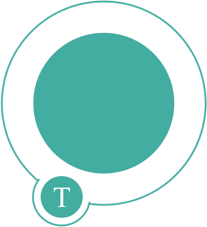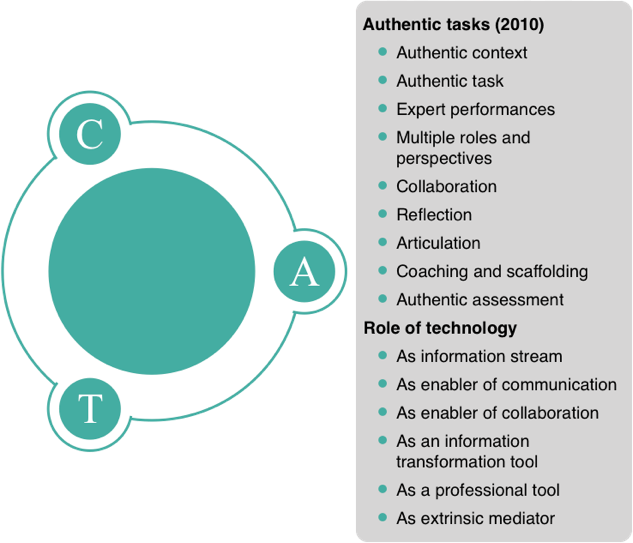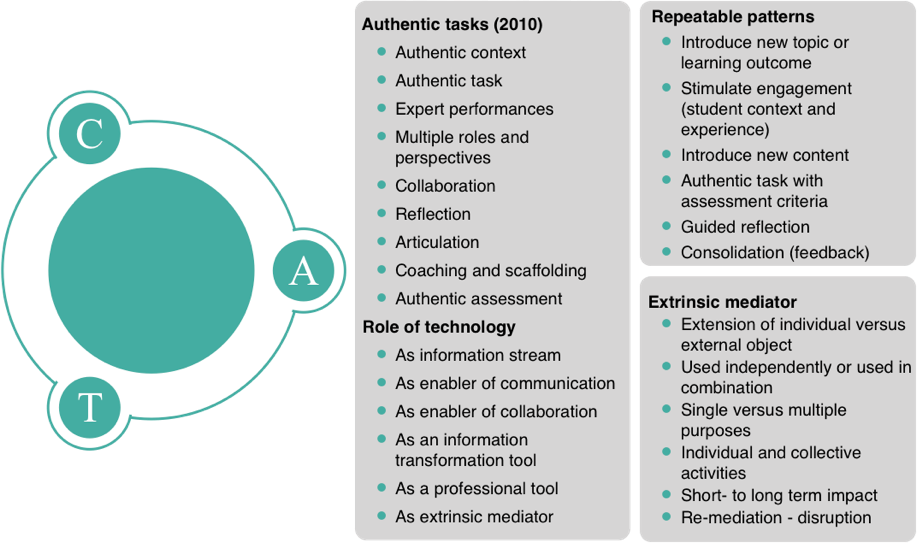Learning with Technology
The role of technology in the design of learning activities is complex and can be viewed from different positions. However, the development of ways to design interactive technology based on theories used in contemporary learning design (authentic activities and collaboration), provides an opportunity to develop an integrated framework. First, a number of stories illustrate important aspects of learning design that include the use of technology (authentic activity, technology/tool mediation and collaboration). Thereafter, lessons learnt from human computer interaction designs are explored to develop a better understanding of how to create technological supported learning design.
The first story is about a young man, Dave, who took on leadership roles during a class project as reported by Roth and Lee (2007). Seventh-grade teachers brought to class a newspaper article on environmentalists concerned with the health of an important local river system. The article explained how this river was polluted and called for action to improve the ecosystem. The teachers asked the students if they wanted to undertake projects that would address environmental problems associated with the creek. Working in groups, students enthusiastically took up the challenge and designed projects to investigate the creek. One of the students, Dave, took on many different roles during the investigation: he collected useful data and presented the information in graphical format; he made presentations to other classes and showed teachers how to undertake scientific studies in the creek. In addition, he acted as a peer tutor during their fieldwork. During the presentations of the students’ project to parents and the community he discussed environmental research with adults and children. However, in the mathematics class Dave was “on task” for only short periods of time and was not able to concentrate during a lesson, he could not draw graphs, and was often removed from the classroom for special attention. In fact, due to his apparent inability to function in the mathematics class, Dave was diagnosed as suffering from attention deficit hyperactive disorder. How can it be that in one situation Dave showed strong leadership qualities and above average skills and participation (he was one of the stars of the show) and in another he was labelled problematic?
 Roth and Lee (2007) suggested that in the environmental unit students were given the opportunity to decide what they wanted to do and also the way in which they wished to undertake their investigations. Their research topics and methods were discussed with and agreed to by their peers and teachers. The students therefore chose their activities and, through interactions and discussions, decided on the appropriate methods to undertake their scientific investigations. In the mathematics class Dave was neither able to specify his activity, nor was he able to choose how to undertake the mathematics task. In the environmental class Dave was able to mediate his own learning, and through his involvement with his peers and teachers he mediated, or facilitated, the learning of others. This example illustrates how authentic learning tasks can be inclusive to support meaningful learning. Authentic learning tasks include nine elements:
Roth and Lee (2007) suggested that in the environmental unit students were given the opportunity to decide what they wanted to do and also the way in which they wished to undertake their investigations. Their research topics and methods were discussed with and agreed to by their peers and teachers. The students therefore chose their activities and, through interactions and discussions, decided on the appropriate methods to undertake their scientific investigations. In the mathematics class Dave was neither able to specify his activity, nor was he able to choose how to undertake the mathematics task. In the environmental class Dave was able to mediate his own learning, and through his involvement with his peers and teachers he mediated, or facilitated, the learning of others. This example illustrates how authentic learning tasks can be inclusive to support meaningful learning. Authentic learning tasks include nine elements:
- Provide authentic contexts that reflect the way the knowledge will be used in real life
- Provide authentic tasks and activities
- Provide access to expert performances and the modelling of processes
- Provide multiple roles and perspectives
- Support collaborative construction of knowledge
- Promote reflection to enable abstractions to be formed
- Promote articulation to enable tacit knowledge to be made explicit
- Provide coaching and scaffolding by the teacher at critical times
- Provide for authentic assessment of learning within the tasks.
Herrington (2014)
The next story is about a researcher, John Seely Brown, an expert in technology-based tutoring systems. Brown was employed at Xerox to investigate the use of artificial intelligence to improve the problem-solving skills of the technology support engineers who repaired Xerox copiers and printers (Brown, 1999). Before starting on a complex technology solution to the problem, Brown employed a number of social scientists to spend time and work with the engineers. To their surprise, the technical representatives did not use the manuals to troubleshoot broken machines; they rather called other technicians to discuss the problem. “Troubleshooting for these guys is really just weaving together a narrative, a narrative that eventually explains all the symptoms and test data of this machine. And when they have made sense of all the data, the narrative is finished and the machine is diagnosed” (Brown, 1999, 13). How did Brown support training initiatives at Xerox?
Did he build complex tutoring systems to “train” the technicians so that they undertook their tasks of troubleshooting in an appropriate way? Or did he build an online learning system that provided all the technical information required by the technical staff to do their job? He did neither. Brown (1999, 13) wrote: “What kind of system did we design, because of course as a technologist I was expected to build a system? We created a beautifully simple system, one that involved using two-way radio and no computers. We gave everyone in our tech rep community-of-practice test site a two-way radio, a radio that was always on, with their own private network. Because it was on, they were always in each other’s periphery. …And so basically we created a multiprocessing, multi-person storytelling process”. These solutions worked so well that it saved Xerox millions of dollars. While there may be many other reasons why this solution worked, the use of the two-way radios is important.
 The always on two-way radios mediated the development of a social community. In this novice community members might not contribute to the conversation soon after joining the group, but lurk on the periphery, listening to the way in which the technical representatives solve problems. Brown (1999) suggested that by doing so, novice representatives became virtual cognitive apprentices. One of the problems associated with this solution was that the stories were lost. To solve this problem, Brown created a web-based system in which the representatives could collect, evaluate and refine their stories. So, the solution developed by Brown to support the Xerox technical representatives included two technological tools: two-way radios and a social network web-based system. These tools mediated development of knowledge to solve troubleshooting problems that the technical representatives experienced. Technology can be used in a number of ways in teaching and learning, including:
The always on two-way radios mediated the development of a social community. In this novice community members might not contribute to the conversation soon after joining the group, but lurk on the periphery, listening to the way in which the technical representatives solve problems. Brown (1999) suggested that by doing so, novice representatives became virtual cognitive apprentices. One of the problems associated with this solution was that the stories were lost. To solve this problem, Brown created a web-based system in which the representatives could collect, evaluate and refine their stories. So, the solution developed by Brown to support the Xerox technical representatives included two technological tools: two-way radios and a social network web-based system. These tools mediated development of knowledge to solve troubleshooting problems that the technical representatives experienced. Technology can be used in a number of ways in teaching and learning, including:
- As an information stream mainly associated with Internet content.
- As an enabler of communication (WhatsApp, SMS and Chat)
- As an enabler of collaboration (writing together with a collaboration tool such as a Google doc)
- As an information transformation tool (using software to transform digital data from one form to other)
- As a professional tool (using a spreadsheet to calculate student grades)
- As an extrinsic mediator.
All human activity is mediated through the tools that we create and technology in a learning design is an extrinsic mediator, as described below.
The third example is about secondary school students playing a computer video game to understand photosynthesis and respiration. Working with senior school students Foko and Amory (2008) wanted to find out if, through playing a computer game, students could overcome misconceptions related to photosynthesis and respiration. Examples of such misconception include the belief that plants photosynthesise during the day and respire at night, that respiration is the opposite of photosynthesis, and that the conversion of carbon dioxide to oxygen is a simple process. The game included specifically designed puzzles to directly challenge players’ understanding of these key concepts. Most of the students had never before played a computer game. Foko and Amory (2008) used a knowledge test to determine what the students knew about photosynthesis and respiration before and after playing the game. Each participant played the game on their own computer and at the end of the session most of them had successfully solved all the puzzles, but this did not necessarily mean that students’ understanding had increased.
 To Foko and Amory’s (2008) great disappointment, students playing the game did not in any way improve their understanding of photosynthetic and respiratory processes. How was this possible? All the game puzzles had been carefully designed to address specific misconceptions related to photosynthesis and respiration. Yet there was no development of understanding. On further investigation, they found that those students who were unable to solve the puzzles, memorised the puzzle solutions from their peers who could solve the puzzles. Therefore, they did not attempt to solve the problem themselves but reverted to rote learning. Working with another group of students from the same school, Foko asked them to play in pairs and to discuss the puzzles to identify possible solutions. He also invited the students to ask him questions if they were confused. In this case, there was a big difference between the pre- and post-test performance – most students overcame many of the misconceptions related to photosynthesis and respiration. Working together (collaboration) trying to solve problems resulted in a greater understanding of photosynthesis and respiration. Recent research using social network analysis clearly shows that participation in learning communities improves performance, persistance and creativity (see Amory 2017).
To Foko and Amory’s (2008) great disappointment, students playing the game did not in any way improve their understanding of photosynthetic and respiratory processes. How was this possible? All the game puzzles had been carefully designed to address specific misconceptions related to photosynthesis and respiration. Yet there was no development of understanding. On further investigation, they found that those students who were unable to solve the puzzles, memorised the puzzle solutions from their peers who could solve the puzzles. Therefore, they did not attempt to solve the problem themselves but reverted to rote learning. Working with another group of students from the same school, Foko asked them to play in pairs and to discuss the puzzles to identify possible solutions. He also invited the students to ask him questions if they were confused. In this case, there was a big difference between the pre- and post-test performance – most students overcame many of the misconceptions related to photosynthesis and respiration. Working together (collaboration) trying to solve problems resulted in a greater understanding of photosynthesis and respiration. Recent research using social network analysis clearly shows that participation in learning communities improves performance, persistance and creativity (see Amory 2017).

In contemporary collaborative and authentic learning designs technology plays a number of roles with extrinsic mediation being the most important one as this is a core component of Vygotsky's learning theory. However, we need to better understand how to design technological interfaces to encourage such an approach.
Two designs techniques played an important part in the redesign of the African Storybook web site (Amory, 2018). First, the use of repeatable design patterns (Gamma, Helm, Johnson & Vlissides, 1995) made it easier for users to learn how to use the designed interfaces. So to help learners navigate through complex learning tasks, each authentic activity should be designed to include an appropriate pattern:
- Introduce a new topic or learning outcome
- Stimulate engagement (student context and experience)
- Introduce new content
- Include authentic task/s with assessment criteria
- Guided reflection
- Consolidation (feedback).
To support tool mediated learning with technology, Kaptelinin (2015) argues that the concept of mediation be allied to human computer interactions. Important extrinsic mediations to support human computer interactions are:
- Me versus the world
For example, tracker bracelets are designed to form a part, an extension, of the individual (“personal technologies”). TV sets are external objects “out there in the world”, with which we interact. For example, in African Storybook the development of an app to read stories becomes an extension of the individual. - Coupling between different means
Some activity trackers are designed so that they can be used independently from other devices, while other models can only be used in combination with a smartphone. - Versatility
A vending machine can be used for one single purpose while others, for example, word processors, can be used for a variety of purposes. In African Storybook, the web site can be used for different purposes to read, create or for research. - Individual – collective
A design that supports both individual and collective activities. African storybook was designed for individual users, but the ability to print or project storybooks supports collective activities. - Impact
Impact of mediation on actors can either be short-term, such as helping to achieve an immediate goal, or long-term, such as intentional or unintentional transformation of an individual. Storybooks should transform individuals when they learn to read. - Disruptive or incremental
New technologies typically substitute existing meditational means, and the adoption of new technologies causes re-mediation - re-mediation can be associated with a significant disruption. The use of open licences and print-ready pdf storybooks allows them to be printed at low costs, which is disrupting traditional publishing models.

Learning with technology should be a collaborative social learning experience where technology is not only used to access information, support communication, enable collaboration, be used to create new digital objects and as a professional tool, but also as a tool to mediate learning that consists of a number of related authentic tasks that are presented using a repeatable pattern.
List of sources
Amory A. (2018) Use of the Collaboration-Authentic Learning-Technology/Tool Mediation Framework to Address the Theory–Praxis Gap. In: Chang TW., Huang R., Kinshuk (eds) Authentic Learning Through Advances in Technologies. Lecture Notes in Educational Technology. Springer, Singapore.
Amory, A. (2018). Activity theory and interactive design for the African Storybook Initiative. Journal of Educational Multimedia and Hypermedia 27(3), 293-308.
Brown, J. S. (1999). Learning, working & playing in the digital age. AAHE National Conference on Higher Education, Washington, DC, 23 March. Retrieved from http://serendip.brynmawr.edu/sci_edu/seelybrown/s eelybrown.html
Foko, T. & Amory, A. (2008). Social constructivism in games based learning in the South African context. In J. Luca & E. Weippl (Eds.), Proceedings of World Conference on
Educational Multimedia, Hypermedia and Telecommunications (pp. 5757-5764). Chesapeake, VA: AACE.
Herrington, J. (2014) About authentic learning. Retrieved from http://authenticlearning.info/AuthenticLearning/Home.html
Herrington, J. & Oliver, R. (2000). An instructional design framework for authentic learning environments. Educational Technology Research and Development, 48(3), 23-48.
Roth, W. M. & Lee, Y. J. (2007). “Vygotsky's neglected legacy”: Cultural-historical activity theory. Review of Educational Research, 77(2), 186-232.